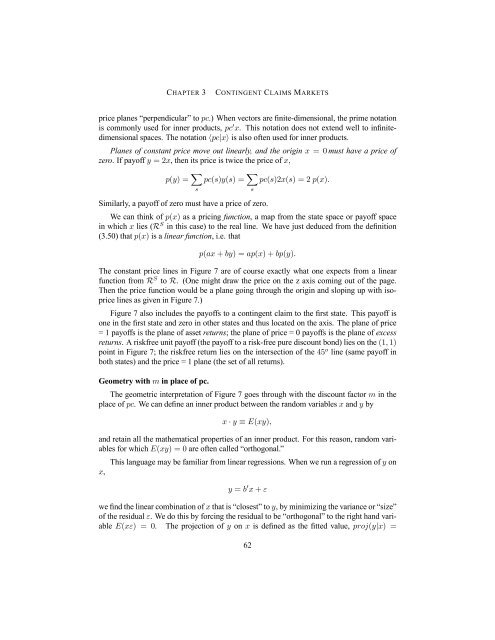Asset Pricing John H. Cochrane June 12, 2000
Asset Pricing John H. Cochrane June 12, 2000
Asset Pricing John H. Cochrane June 12, 2000
Create successful ePaper yourself
Turn your PDF publications into a flip-book with our unique Google optimized e-Paper software.
CHAPTER 3 CONTINGENT CLAIMS MARKETS<br />
price planes “perpendicular” to pc.) When vectors are finite-dimensional, the prime notation<br />
is commonly used for inner products, pc0x. This notation does not extend well to infinitedimensional<br />
spaces. The notation hpc|xi is also often used for inner products.<br />
Planes of constant price move out linearly, and the origin x =0must have a price of<br />
zero. If payoff y =2x, then its price is twice the price of x,<br />
p(y) = X<br />
pc(s)y(s) = X<br />
pc(s)2x(s) =2p(x).<br />
s<br />
Similarly, a payoff of zero must have a price of zero.<br />
We can think of p(x) as a pricing function, a map from the state space or payoff space<br />
in which x lies (RS in this case) to the real line. We have just deduced from the definition<br />
(3.50) that p(x) is a linear function, i.e. that<br />
p(ax + by) =ap(x)+bp(y).<br />
The constant price lines in Figure 7 are of course exactly what one expects from a linear<br />
function from RS to R. (One might draw the price on the z axis coming out of the page.<br />
Then the price function would be a plane going through the origin and sloping up with isoprice<br />
lines as given in Figure 7.)<br />
Figure 7 also includes the payoffs to a contingent claim to the first state. This payoff is<br />
one in the first state and zero in other states and thus located on the axis. The plane of price<br />
= 1 payoffs is the plane of asset returns; the plane of price = 0 payoffs is the plane of excess<br />
returns. A riskfree unit payoff (the payoff to a risk-free pure discount bond) lies on the (1, 1)<br />
point in Figure 7; the riskfree return lies on the intersection of the 45o line (same payoff in<br />
both states) and the price = 1 plane (the set of all returns).<br />
Geometry with m in place of pc.<br />
The geometric interpretation of Figure 7 goes through with the discount factor m in the<br />
place of pc. We can define an inner product between the random variables x and y by<br />
s<br />
x · y ≡ E(xy),<br />
and retain all the mathematical properties of an inner product. For this reason, random variables<br />
for which E(xy) =0are often called “orthogonal.”<br />
This language may be familiar from linear regressions. When we run a regression of y on<br />
x,<br />
y = b 0 x + ε<br />
we find the linear combination of x that is “closest” to y, by minimizing the variance or “size”<br />
of the residual ε. We do this by forcing the residual to be “orthogonal” to the right hand variable<br />
E(xε) = 0. The projection of y on x is defined as the fitted value, proj(y|x) =<br />
62
















